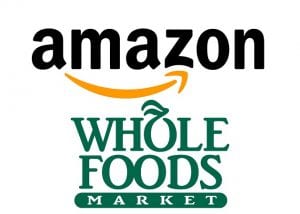
This week Amazon took over as owner of Whole Foods, which is arguably the most noteworthy merger of the summer. It was an intriguing move by Amazon, and one which may prove to be very savvy. Or it could be a bust and set them back many years in their quest to take over Wal-Mart as the largest retailer in the world. Aside from the widely reported grocery price cuts, I have detailed some additional observations and thoughts on the move:
- By acquiring Whole Foods, it provides Amazon with 466 retail stores across the U.S., Canada, and the U.K.. Amazon is known for being an e-commerce power, and for the first time they will now have an actual physical presence in communities they have already been serving. Accordingly, look for Amazon to use Whole Foods locations as more than just a grocery store (pick up/drop up location for e-commerce purchases, customer service center, marketing opportunities, etc.).
- Look for Amazon to transform the way the market orders and delivers groceries in the near-future. Amazon is now the only grocery store provider who also owns their own artificial intelligence device (Amazon Echo); therefore, it seems as though Amazon may have a distinct advantage over other grocery store providers in this regard. Additionally, one of the first moves Amazon made when taking over Whole Foods is they slashed the price of their Echo by 33% and put it on sale in all Whole Foods stores. Amazon’s aggressive push to get their AI device in the hands of as many Whole Foods shoppers as possible seems like a logical first step in transforming the process of acquiring groceries.
- The move has increased competition, as just this week Wal-Mart announced a partnership with Google. Google has their own version of the Echo, and Wal-Mart customers will soon be able to place orders through Google’s version. It is likely not a coincidence that Wal-Mart’s partnership with Google was announced on the same week that Amazon took over Whole Foods.
- Off-line retail is likely not dead, and this deal is proof of such. The deal seems to be more of an indication that a hybrid model is necessary to be a top retailer, and some think Amazon is uniquely positioned to outpace Wal-Mart in a hybrid retail world. Wharton marketing professor, David Bell, noted, “from my experience, companies that start in the digital world and slowly and surely add offline have been more successful than companies that started in the offline world and added digital.”
- It’s being reported that Amazon intends on utilizing its $99 per year Amazon Prime service as the rewards program for Whole Foods shoppers. At-least in the near term, this will likely provide a shot in the arm to increasing Amazon Prime membership.
- The impact this move will have on small retailers remains to be seen. Presumably, some smaller retailers will be phased out of the market in due-time, as they will have trouble remaining competitive with Amazon and Wal-Mart. However, some smaller retailers, especially current vendors of Whole Foods, may find Amazon’s 3rd party online marketplace as a boon to business.
- If Amazon and Wal-Mart both maintain the same revenue growth of the past five years, Amazon will surpass Wal-Mart’s revenue by 2023. This is a big if and by no means a sure thing, as the gap is still quite large. Wal-Mart produced $350 billion more in revenue than Amazon did in 2016, but Amazon is riding a wave of momentum in closing this gap.
Important Disclosure: The above information is not a recommendation or offer to invest in any particular investment and/or strategy. Investing involves risk which may result in a loss.
